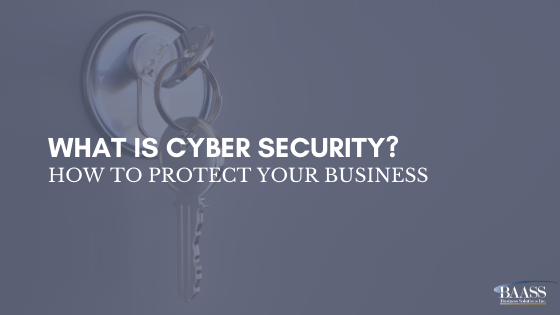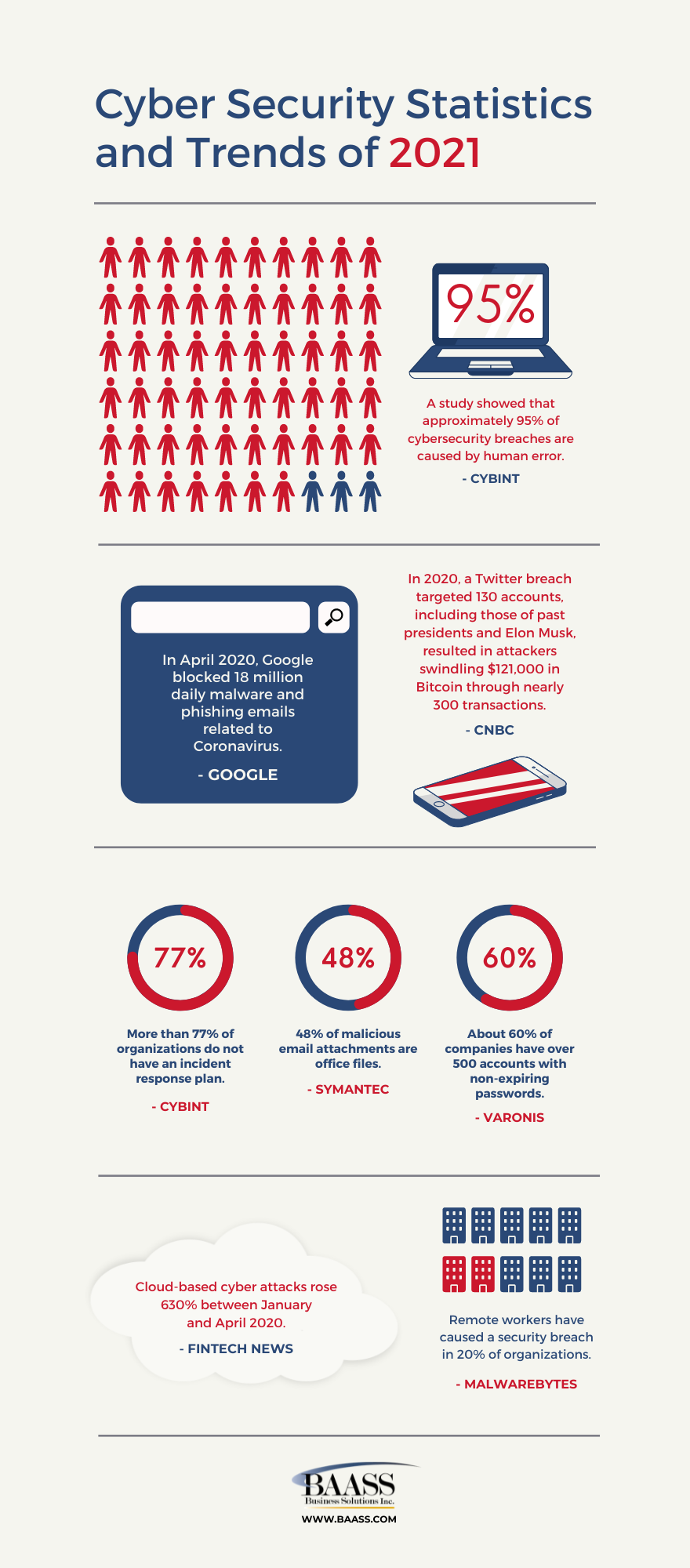
Cyber security is a topic with increasing importance due to remote work and mobile devices on the rise. Many businesses are aware of cyber criminals and security breaches that occur but may not have a full understanding of how common these attacks are, and the various ways these criminals target their victims.
Being aware and prepared is the most important aspect when it comes to cyber security. With the volume and sophistication of cyber attacks continuing to grow, it is important for companies to implement policies and procedures to protect their sensitive business and personnel information. In this blog we will give insight into what cyber security is, common scams, why it is important, and more.
What is Cyber security?
Cyber security refers to the protection of devices, programs, networks and data from attack, damage, or unauthorized access; most commonly from cyber threats or criminals. There are various forms of cyber security, although most common are technologies, processes, and practices.
Why is Cyber Security important?
Cyber security is important for various reasons, however, most importantly to keep your sensitive data protected from unknown threats. Sensitive data can consist of intellectual property, financial data, personal information etc. that could have negative consequences if released to the wrong individual(s).
If your business holds sensitive information for clients it is an obligation to make sure it is protected with systems in place in order for customers to feel comfortable sharing personal or payment information. On the day to day, businesses transfer sensitive information across networks and to other devices in order to complete various tasks. Cyber security describes the discipline dedicated to protecting that information and the systems used to process or store it.
What is a Cyber Security Threat?
A cyber security threat refers to any malicious attack that seeks unauthorized access to data, disrupts operations or damages information, networks, etc. Cyber threats come in various forms, and are brainstormed, planned, and executed by cybercriminals.
Types of Cyber Security Threats
Malware
Malware is described as any software that was created intentionally to cause harm to a computer, server, client, device, computer network, etc. Malware attacks are the most common form of cyber attacks and can be conducted by installing malicious software, spyware, ransomware, virus, worms onto a device for malicious use.
Malware is most commonly a link clicked on through the internet or email and installed directly onto a device with the belief by the user it is something else. Once downloaded into a system, malware can block access to critical components of the network, damage the system, and gather confidential information, among other malicious acts.
Phishing
Phishing occurs when cybercriminals send emails appearing to be from a legitimate source, with a reason to be contacted. However, these emails contain malicious links disguised as something else. When clicked leading to the installation of malware or disclosure of sensitive information like credit card details or login credentials.
A quick and simple rule to identify a phishing email is by using the “SLAM” Method which stands for sender, links, attachments and message. Take a close look at each of these aspects, and make sure to only ever hover over links — never click, unless you are confident they are secure.
Spear Phishing
Similar to Phishing, Spear Phishing is a more targeted attack at certain individuals. Cybercriminals often base these attacks on individuals in companies that have a higher status, this is due to them having more access to information as well as often a more willingness to compromise.
Man in the Middle Attack
This type of attack occurs when a cybercriminal places themselves within the middle of a communication between two individuals. They then listen for sensitive information, passwords, or anything that they could use in order to gain data or black mail for future attacks.
Denial of Service Attack
Distributed Denial of Service commonly referred to (DDoS) attacks consist of flooding one machine or network. This causes the source to become unavailable to its intended users by temporarily or indefinitely disrupting services of a host connected to the Internet.
Advanced Persistent Threats (APT)
This type of threat occurs when a cybercriminal effectively gains unauthorized access to a system or network and remains undetected for an extended time.
Ransomware
Ransomware is a form of malware, where data is encrypted and the victim's information is held at ransom in return for a desired action or price.
Password Attacks
Password attacks are one of the most common forms of corporate and personal data breach. A password attack is simply when a hacker tries to steal your login credentials in order to gain unauthorized access to data. Cybercriminals in some cases will take over accounts they gain access to in order to execute other attacks within that individual's network.
Common Types of Security
Infrastructure Security
Infrastructure security refers to the protective barriers in place within a building or area of importance in order to protect the data, information or devices within. An example of infrastructure security would be having a code or card to get through certain entrances/ access certain areas within a location.
Application Security
Application security could also be referred to as computer security and consists of downloadable programs or processes in place to protect software and applications on a device. These programs work as a protective barrier making it more difficult for cybercriminals to access information, and in the scenario that malware makes its way onto a device it will be recognized sooner and acted on faster before it becomes too late to reverse damage.
Types of application security:
- Anti-Virus Programs
- Firewalls
- Encryption Programs
Network Security
Most commonly applied to enterprise IT environments, network security is implemented by installing preventative measures to a network in order to deny unauthorized access, modification, deletion, or theft of information. An example of this could be two factor authentication, a VPN or other login credentials needed to access a network.
Cloud Security
With many businesses moving data into the Cloud, this is another type of security that has become increasingly important over the years. Cloud Security consists of tools and software that are designed to protect data in your cloud resources. Cloud providers are constantly creating and implementing new security tools to help enterprise users better secure their data. This means if your business is being hosted by a cloud provider you should be aware of the tools, processes and procedures they have in place to ensure data security.
Check out these: Cloud Security Myths Debunked
Internet of Things (IoT) Security
The Internet of Things (IoT) refers to the network of everyday web-enabled “smart” objects that can connect and exchange information. In addition to your computer, smartphone or tablet, these can include things like fitness trackers, TVS, speakers, cars, etc.
As more IoT products are brought into the workplace, it is important for your organization to have policies and procedures in place in order to minimize the possibility of cyber security incidents on your network. Some ways to improve the security of these “smart objects” is through strong passwords or two factor authentication (2FA), encrypting data, turning off manual functionality, or restricting these devices to a specific network.
Tips for Managing Cyber Security
It is important to conduct risk assessments, update computer systems and software systems, create secure system networks, and install various security solutions available to help to avoid risk of cyber attacks. Although it is important as a business to implement security for all 5 types of security above, here are 7 tips we suggest to improve security:
- Have a Secure Wi-Fi Network
- Be Aware of phishing Emails and Sites
- Create Strong Passwords and Lock Devices
- Set Up a Firewall and Use Anti-Spam Software
- Deploy a VPN
- Save and Back Up Data Frequently
- Educate Employees
Read more about these 7 tips in our blog:
7 Tips on How to Improve Cyber Security While Working Remotely
In Closing
With the volume and sophistication of cyber attacks continuing to grow, it is vital for your organization to ensure you are secure. Taking the time to develop a plan, procedure, policies and training will help to educate employees, keep sensitive data secure and minimize risks. There are various threats and cybercriminals to be aware of, it is important to do your research while implementing a barrier to ensure your business is prepared from all angles.
If you want to learn more about if your business is secure as well as how to be vigilant against potential security threats, register for our webinar Security and Awareness: Are You Secure? Also, be sure to check out this list of common Covid-19 Scams.

